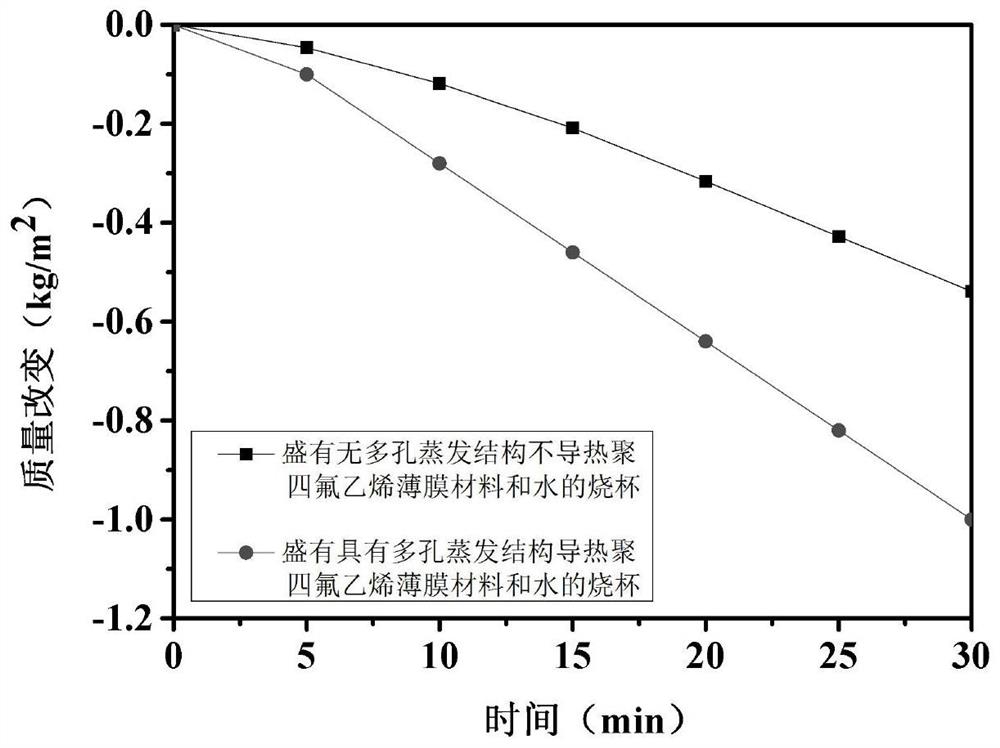Thermally conductive polytetrafluoroethylene film with porous structure and preparation method thereof
A polytetrafluoroethylene film and a polytetrafluoroethylene technology are applied in the field of thermally conductive polytetrafluoroethylene film and its preparation, and can solve the problems of unfavorable industrial production, poor product use effect, complex process and the like
- Summary
- Abstract
- Description
- Claims
- Application Information
AI Technical Summary
Problems solved by technology
Method used
Image
Examples
Embodiment 1
[0034]A method for preparing a thermally conductive polytetrafluoroethylene film material having a porous structure, comprising the steps of:
[0035]Step 1: A polypropylene nonwoven fabric is bonded to the polytetrafluoroethylene film by hot pressing.
[0036]Step 2: The polytetrafluoroethylene film of the polypropylene nonwoven fabric is bonded in the oxygen plasma treatment step 1, and the treatment time is 300s;
[0037]Step 3: Soak the polytetrafluoroethylene film after plasma treatment in anhydrous ethanol for 240 min;
[0038]Step 4: Add the graphene dispersion to distilled water, stir mix, and tested for 60 min, and prepared a graphene immersion liquid having a concentration of 0.4%, and the diameter of graphene was 10-100 nm;
[0039]Step 5: Soaked the polytetrafluoroethylene membrane in anhydrous ethanol to the prepared graphene dispersion, soaking time is 30 min;
[0040]Step 6: Take out the soaked polytetrafluoroethylene film and dry the finished product at 100 ° C.
Embodiment 2
[0042]A method for preparing a thermally conductive polytetrafluoroethylene film material having a porous structure, comprising the steps of:
[0043]Step 1: A polypropylene nonwoven fabric is bonded to the polytetrafluoroethylene film by hot pressing.
[0044]Step 2: The polytetrafluoroethylene film of the polypropylene nonwoven fabric is bonded in the oxygen plasma treatment step 1, and the treatment time is 300s;
[0045]Step 3: Soak the polytetrafluoroethylene film after plasma treatment in anhydrous ethanol for 120 min;
[0046]Step 4: Add the graphene dispersion to distilled water, stir mix, and tested for 30 min, and prepared a concentration of 0.6% graphene soaking solution, graphene diameter of 10-100 nm;
[0047]Step 5: Soak the polytetrafluoroethylene membrane soaked in absolute ethanol into the prepared graphene dispersion for 10 minutes;
[0048]Step 6: Take out the soaked PTFE membrane and directly dry it at 100°C.
Embodiment 3
[0050]The preparation method of a thermally conductive polytetrafluoroethylene film material with a porous structure includes the following steps:
[0051]Step 1: Laminate the polypropylene non-woven fabric to the polytetrafluoroethylene film by hot pressing;
[0052]Step 2: Use oxygen plasma to treat the polytetrafluoroethylene film laminated with polypropylene non-woven fabric in step 1, and the treatment time is 300s;
[0053]Step 3: Soak the plasma-treated PTFE membrane in absolute ethanol for 100 minutes;
[0054]Step 4: Add the graphene dispersion to distilled water, stir and mix, and ultrasonically treat for 30 minutes to prepare a graphene soaking solution with a concentration of 0.1%, the diameter of the graphene is 10-100nm;
[0055]Step 5: Immerse the polytetrafluoroethylene membrane soaked in absolute ethanol into the prepared graphene dispersion for 60 minutes;
[0056]Step 6: Take out the soaked PTFE membrane and directly dry it at 150°C.
PUM
| Property | Measurement | Unit |
|---|---|---|
| diameter | aaaaa | aaaaa |
Abstract
Description
Claims
Application Information
 Login to View More
Login to View More - R&D
- Intellectual Property
- Life Sciences
- Materials
- Tech Scout
- Unparalleled Data Quality
- Higher Quality Content
- 60% Fewer Hallucinations
Browse by: Latest US Patents, China's latest patents, Technical Efficacy Thesaurus, Application Domain, Technology Topic, Popular Technical Reports.
© 2025 PatSnap. All rights reserved.Legal|Privacy policy|Modern Slavery Act Transparency Statement|Sitemap|About US| Contact US: help@patsnap.com



